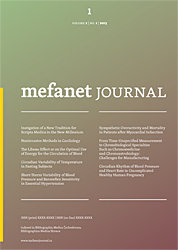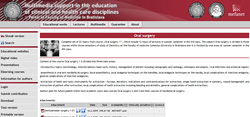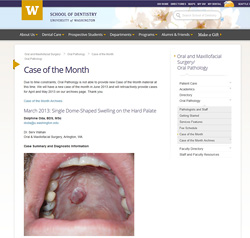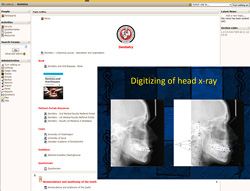
MEFANET Journal 2013; 1(1): 5–10
ORIGINAL ARTICLE
Web‐based interactive learning programs for dentistry concept and its evaluation
Jitka Feberová1, Taťjána Dostálová2,*, Alexandra Polášková1, Michaela Seydlová2
1 Charles University Computer Centre, 2nd Faculty of Medicine, Charles University in Prague, Prague, Czech Republic
2 Department of Stomatology, 2nd Faculty of Medicine, Charles University in Prague, Prague, Czech Republic
* Corresponding author: Tatjana.Dostalova@fnmotol.cz
Abstract
Article history:
Received 18 February 2013
Revised 29 May 2013
Accepted 31 May 2013
Available online 4 June 2013
Peer review:
Ladislav Dušek, Ondřej Liberda
 Download PDF
Download PDF
The change in pedagogy relates partly to the development of electronic media and communication possibilities that are available in networked environments. This new technology dominates and supports the international educational content and learning. The aim of our study was to evaluate this progress in dental education. The education was compared parallel in two groups of Czech and international students. Groups and teaching hours were in the fourth year of the MD curriculum. Stomatology course materials were prepared and published on the portals of the individual dental study programs (http://dl.cuni.cz). The lectures had different access levels, ranging from materials that were freely available to all International WEB dental faculties’ sources to materials that were accessible only after receiving permission from the authors. A number of software tools were used for the creation of e-learning courses, such as, e.g., WebCT, Blackboard, Adobe Connect or Microsoft Class Server. The 291 students who were included in our study were divided into two groups according to the e-learning program. The goal of our study was to check student activities during the educational process, namely online work – lessons, articles, videos, literature, quizzes and direct Internet access. The statisticaly significant differences were found in the results of the questionnaire based on five-point Likert scale. The Mann Whitney non-parametric test was used to evaluate students’ activities during the education process. The e-learning course had a direct influence on learning experiences, dental information, opinions and comments. Our results verified that satisfaction is an important and influential factor in determining whether a student decides to choose a dentistry and maxillofacial surgery course. Students prefer to have more time for practical therapy in the clinic. It was demonstrated that examination results did not correspond to the type of education but it was confirmed that e-learning helped to prepare students for practical training.
Keywords
e-learning, dentistry, evaluation
Introduction
The change in pedagogy relates partly to the development of electronic media and communication possibilities that are available in networked environments. This new technology dominated the process and took the focus away from the educational content and learning. It has now reached a more mature state and the focus is now placed increasingly on content, learning and outcome. A prerequisite for a rational learning process is that knowledge is easily accessible, searchable and retrievable. In this respect electronic technology is a necessary tool in modern learning.
Figure 1: Dental study programs - MEFANET - Faculty of Medicine Comenius University in Bratislava portal
Figure 2: International WEB dental faculties’ open sources - School of Dentistry- University of Washington
Figure 3: Dental study programs (http://dl.cuni.cz)
Figure 4: Interactive treatment planning
Computer-aided learning was first employed in 1971 at the University of Kentucky and has since been developed in three main directions – computer-based training, web-based training and the learning management system (http://www.pbs.org/als/dlweek/history/index.html), the most advanced method of e-learning [1]. The learning management system encompasses a wide array of instructional methodologies and tools and represents an accessible, interactive and flexible way of giving multimedia presentations and of utilizing text and visual materials, as well as sound and motion. Rosenberg’s literary review [2] confirms the benefit of computer-aided learning, while Mattheos [3] emphasizes the necessity for important conditions to be met in order to ensure the quality of e-learning: the quality of learning materials, which must have well-defined learning objectives, be up-to-date, and use evidence-based data. Furthermore, consideration must be taken of developers’ intellectual rights, and original content needs to be secure from unauthorized changes. These points must be fulfilled by the creator of the e-learning course. Once these conditions have been met, the e-learning course is made accessible to students. Some studies even demonstrate that students using computer-aided learning require less time to achieve learning objectives. Students using e-learning achieve better final results than students who have not had access to computer-aided learning [4]. Dental education is an ever-changing, competitive, challenging and complex environment, where the development of new dental schools globally is the order of the day [5].
In the same time it is a challenge of how utilize them in dental education the best way. The year 2005 meant the initiation of the MEFANET project (MEdical FAculties NETwork, http://www.mefanet.cz/index-en.php), which allowed international, effective and open cooperation between all medical faculties in the Czech Republic and Slovakia. Amongst the fundamental goals of the project is the advancement of medical teaching and learning through the use of modern information and communication technologies. As the means to achieve this goal, MEFANET decided to develop an original and uniform solution for educational web portals, which are used, together with a central access point (http://portal.mefanet.cz/index.php), to offer and share digital educational content. This has allowed the growth of a unique collaborative environment, full of shared resources [6].
For that reason the aim of our study was to evaluate the results of Czech-English education courses in Dentistry for students of general medicine and to compare students with access to Internet based e-learning courses to those without it.
Course arrangement
The education was compared parallel in two groups of Czech and international students. Groups and teaching hours were in the fourth year of the MD curriculum: Stomatology – course duration 10 days – examination – 4 EC credits; book – Dentistry and Oral Diseases; 10 lectures – traditional lectures (years 2008–2009) or e-learning education (years 2010–2012); 10 lectures – contact hours.
Materials were published on the portals of the individual dental study programs (http://dl.cuni.cz). The lectures had different access levels, ranging from materials that were freely available to all International WEB dental faculties’ sources (Figure 1, 2) to materials that were accessible only after receiving permission from the authors (Figure 3, 4). A number of software tools were used for the creation of e-learning courses, such as, e.g., WebCT, Blackboard, Adobe Connect or Microsoft Class Server.
Dentistry course evaluation
The 291 students who were included in our study were divided into two groups according to the e-learning program: those with classical courses only (N = 161; 130 – Czech students; 31 – international group; 81 women and 80 men with average age 24 years), and those with e-learning lectures (N = 130; 105 – Czech students; 25 – international group; 60 women and 45 men with average age 24 years). All students were asked to fulfill a anonymous questionnaire in one session. Learning contents were provided through the university’s website (http://www.cuni.cz) via personal login.
The questionnaire based on a five-point Likert scale was used to check student activities during the educational process [6] (Table 1).
Table 1: The questionnaire
|
Questionnaire - Five-point Likert Scale Evaluation |
|
|
1. |
Effective use was made of which percentage of lessons |
|
2. |
Adherence to the schedule |
|
3. |
The online presentation of this school department |
|
4. |
The selection of recommended literature |
|
5. |
If a lesson was announced in advance to be led by a specific teacher, was this adhered to: |
|
6. |
During the course we clarified with teachers all important technical concepts (principles, skills ...) |
|
7. |
To what extent do you agree with the following statement: seminars (or practical exercises) |
|
8. |
When teaching the subject/course teachers showed us how the subject matter discussed related |
|
9. |
Were you satisfied with the quality of discussion? |
|
10. |
Do you agree that tutor’s attitude to students was mainly open and respectful? |
|
11. |
Do you think that number of students per tutor was adequate? |
Results
The Mann Whitney non-parametric test was used to evaluate students’ activities during the education process. A non-parametric test (distribution-free) compared two independent groups with and without e-learning education.
The statistical significant differences were found in the results of the questionnaire based on five-point Likert scale. It was confirmed that students using the e-learning system have seen greater benefits in theoretical and practical training (p ≤ 0.05), Table 2, pp. 6–7.
Table 2: Questionnaire Results - Mann Whitney non-parametric test evaluation
|
Question/scale |
Year 2008-2009 answers |
Year 2011-2012 answers |
Mann Whitney test results |
|
Effective use was made of which percentage of lessons (estimated): |
|||
|
1 - almost 100% |
47 (44%) |
55 (64%) |
p<0.05 |
|
2 - more than 70% |
36 (33%) |
28 (33%) |
|
|
3 - approximately half |
19 (18%) |
2 (2%) |
|
|
4 - less than half |
5 (5%) |
1 (1%) |
|
|
5 - cannot judge |
1 (1%) |
0 (0%) |
|
|
Adherence to the schedule was: |
|||
|
1- very good |
44 (41%) |
61 (71%) |
p<0.05 |
|
2 - good |
53 (49%) |
24 (28%) |
|
|
3 - bad |
9 (8%) |
0 (0%) |
|
|
4 - very bad |
2 (2%) |
0 (0%) |
|
|
5 - don´t know |
0 (0%) |
1 (1%) |
|
|
The online presentation of this school department is: |
|||
|
1- very good |
24 (22%) |
37 (43%) |
p<0.05 |
|
2 - good |
43 (40%) |
25 (29%) |
|
|
3 - bad |
10 (9%) |
3 (3%) |
|
|
4 - very bad |
4 (4%) |
0 (0%) |
|
|
5 - don´t know |
26 (24%) |
21 (24%) |
|
|
The selection of recommended literature is: |
|||
|
1- very good |
62 (58%) |
65 (76%) |
p<0.05 |
|
2 - good |
33 (31%) |
16 (19%) |
|
|
3 - bad |
8 (7%) |
2 (2%) |
|
|
4 - very bad |
4 (4%) |
0 (0%) |
|
|
5 - don´t know |
0 (0%) |
2 (2%) |
|
|
If a lesson was announced in advance to be led by a specific teacher, was this adhered to: |
|||
|
1 - (almost) always |
69 (64%) |
79 (92%) |
p<0.05 |
|
2 - in more than 70% |
30 (28%) |
5 (6%) |
|
|
3 - in about half lessons |
6 (6%) |
1 (1%) |
|
|
4 - in less than half lessons |
2 (2%) |
0 (0%) |
|
|
5 - cannot judge |
1 (1%) |
1 (1%) |
|
|
During the course we clarified with teachers all important technical concepts (principles, skills ...) |
|||
|
1 - totally agree |
63 (58%) |
53 (63%) |
p<0.05 |
|
2 - rather agree |
2 (2%) |
28 (33%) |
|
|
3- rather disagree |
37 (34%) |
3 (4%) |
|
|
4 - totally disagree |
6 (6%) |
0 (0%) |
|
|
5 - do not wish to answer |
0 (0%) |
0 (0%) |
|
|
To what extent do you agree with the following statement: seminars (or practical exercises) |
|||
|
1 - totally agree |
43 (40%) |
54 (63%) |
p<0.05 |
|
2 - rather agree |
50 (46%) |
29 (34%) |
|
|
3- rather disagree |
12 (11%) |
1 (1%) |
|
|
4 - totally disagree |
3 (3%) |
1 (1%) |
|
|
5 - do not wish to answer |
0 (0%) |
1 (1%) |
|
|
When teaching the subject/course teachers showed us how the subject matter discussed related |
|||
|
1 - totally agree |
36 (35%) |
60 (70%) |
p<0.05 |
|
2 - rather agree |
49 (48%) |
24 (28%) |
|
|
3 - rather disagree |
13 (13%) |
1 (1%) |
|
|
4 - totally disagree |
5 (5%) |
1 (1%) |
|
|
5 - do not wish to answer |
0 (0%) |
0 (0%) |
|
|
Were you satisfied with the quality of discussion? |
|||
|
1 - absolutely yes |
42 (40%) |
61 (72%) |
p<0.05 |
|
2 - rather yes |
51 (48%) |
23 (27%) |
|
|
3 - rather not |
10 (9%) |
0 (0%) |
|
|
4 - absolutely not |
3 (3%) |
1 (1%) |
|
|
5 - don´t know |
0 (0%) |
0 (0%) |
|
|
Do you agree that tutor's attitude to students was mainly open and respectful? |
|||
|
1 - absolutely yes |
48 (45%) |
71 (83%) |
p<0.05 |
|
2 - rather yes |
46 (43%) |
12 (14%) |
|
|
3 - rather not |
10 (9%) |
2 (2%) |
|
|
4 - absolutely not |
3 (3%) |
0 (0%) |
|
|
5 - don´t know |
0 (0%) |
1 (1%) |
|
|
Do you think that number of students per tutor was adequate? |
|||
|
1 - absolutely yes |
42 (40%) |
50 (58%) |
p<0.05 |
|
2 - rather yes |
36 (34%) |
22 (26%) |
|
|
3 - rather not |
15 (14%) |
10 (12%) |
|
|
4 - absolutely not |
12 (11%) |
2 (2%) |
|
|
5 - don´t know |
0 (0%) |
2 (2%) |
|
Discussion
Hillenburg’s questionnaire [6] showed that e-learning would play an important role in the future of education. Our questionnaire confirmed that the e-learning helped to prepare the practical training better than special book only. It was also suggested that standardized courses should be developed and taught by recognized authorities in dental education. These conditions were met and the results did not show absolute acceptance by students. It was judged that the results of computer-aided learning are similar to or even better than those of traditional methods [7].
It was observed that students would like to use e-learning for their education. Very few dental students have tried animated multimedia software during their education [7]. Peroz’ study [8] confirmed that students enjoyed the oral lecture significantly more than the computer aided learning (CAD) online tool, but favored their use as a supplement to this.
From our previous results, it can be seen that students used e-learning programs to a greater degree than when they did not have access to any other source of information (classic textbooks, lectures) and in rapidly developing subjects with new procedures [4].
Conclusion
The e-learning course has a direct influence on learning experiences, dental information, opinions and comments. Our results verified that satisfaction is an important and influential factor in determining whether a student decides to choose a dentistry and maxillofacial surgery course. Students should be given time for practical therapy in the clinic. The findings highlighted the importance of e-learning to training in dentistry and maxillofacial surgery. It was observed that students would like to use e-learning for their training. It was confirmed that students enjoyed the oral lectures significantly more than computer-aided learning online tools, but favored their use as a supplement to this. It was demonstrated that examination results did not correspond to the type of education but it was confirmed that e-learning helped to prepare students for practical training. The e-learning course had a direct influence on learning experiences, dental information, opinions and comments.
Acknowledgements
The study was supported by project No. CSM 54, Prvouk 28, and 00064203 (the Motol University Hospital).
References
[1] Rosenberg H, Grad HA, Matear DW. The effectiveness of computer-aided, self-instructional programs in dental education: a systematic review of the literature. Eur J Dent Educ 2003; 67(5): 524–532.
[2] Hu J, Yu H, Shao J, Li Z, Wang J, Wang Y. Effects of dental 3D multimedia system on the performance of junior dental students in preclinical practice: a report from China. Adv Health Sci Educ Theory Pract 2009; 14(1): 123–133.
[3] Schönwetter DJ, Reynolds PA, Eaton KA, De Vries J. Online learning in dentistry: an overview of the future direction for dental education. J Oral Rehabil 2010; 37(12): 927–940.
[4] Feberová J, Dostalová T, Hladíková M, Kasal P, Polášek J, Seydlová M, Janda A, Schwarz D. Evaluation of 5-year Experience with E-learning Techniques at Charles University in Prague. Impact on Quality of Teaching and Students’ Achievements. New Educational Review 2010; 21(2): 110–120.
[5] DeLone WH, McLean ER. The DeLone and McLean model of information systems success: a ten-year update. J Manage Inform Syst 2003; 19(4): 9–30.
[6] Hillenburg KL, Cederberg RA, Gray SA, Hurst CL, Johnson GK, Potter BJ. E-learning and the future of dental education: opinions of administrators and information technology specialists. Eur J Dent Educ 2006; 10(3): 169–177.
[7] Peroz I, Beuche A, Peroz N. Randomized controlled trial comparing lecture versus self studying by an online tool Randomized controlled trial comparing lecture versus self studying by an online tool. Med Teach 2009; 31(6): 508–512.
Please cite as:
Feberová J, Dostálová T, Polášková A, Seydlová M. Web‐based interactive learning programs for dentistry concept and its evaluation. MEFANET Journal 2013; 1(1): 5–10. Available at WWW: http://mj.mefanet.cz/mj-01130218.
This is an open-access article distributed under the terms of the Creative Commons Attribution-NonCommercial-ShareAlike 3.0 License (http://creativecommons.org/licenses/by-nc-sa/3.0/), which permits unrestricted use, distribution, and reproduction in any medium, provided the original work, first published in the MEFANET Journal, is properly cited. The complete bibliographic information, a link to the original publication on http://www.mj.mefanet.cz/, as well as this copyright and license information must be included.














